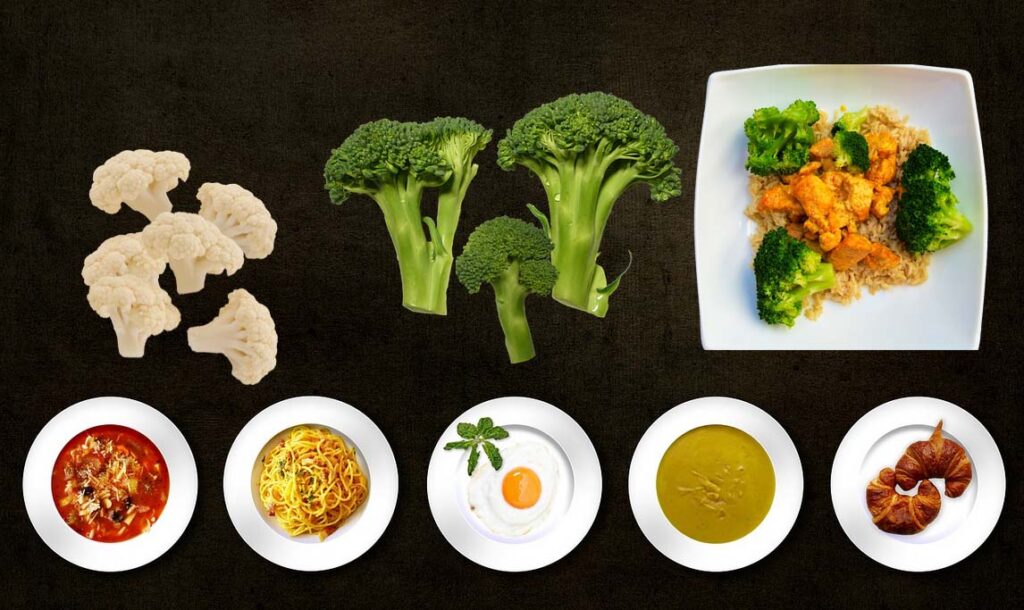
Here are some mouthwatering methods for cooking cruciferous vegetables:
- Roasting: Cruciferous vegetables have a delightful flavour and a crispy texture when roasted in the oven with some oil, salt, pepper and herbs. Particularly well-liked sides are roasted broccoli and cauliflower.
- Steaming: A quick and wholesome approach to prepare cruciferous vegetables is to steam them. While making them simple to digest, steaming aids in the preservation of the nutrients.
- Sautéing: A quick and simple approach to prepare cruciferous vegetables is to sauté them in a pan with some oil and seasonings. For cruciferous veggies that have been sautéed common seasonings include garlic, ginger and soy sauce.
- Grilling: A terrific technique to give cruciferous veggies a smokey flavour and a lovely sear is to grill them over an open flame.
- Stir-frying: A quick and simple approach to prepare cruciferous vegetables is to stir-fry them in a pan with some oil and seasonings. Cruciferous vegetables are frequently seasoned with garlic, ginger and soy sauce.
- Blanching: Blanching cruciferous veggies is a terrific technique to get them ready for salads and sandwiches. Blanching is the process of momentarily immersing produce in boiling water before instantly cooling it off in icy water. The vegetables’ colour and crispness are preserved as a result.
- Fermenting: Cruciferous vegetables can be preserved and given a special flavour by fermenting. Two well-known varieties of fermented cruciferous vegetables are sauerkraut and kimchi.
- Mashed: A tasty and healthy substitute for mashed potatoes is mashed cauliflower. To enhance the flavour, you can add butter, sour cream or cheese.
- Raw: Cruciferous vegetables can keep a lot of their nutrients and enzymes by being eaten raw. Some ways to consume them raw are in a salad or as a snack with a dip.
- Pickling: Another excellent approach to preserve and flavour cruciferous veggies is to pickle them. Examples include pickled radishes, cauliflower and broccoli.
- Adding to soups: One excellent technique to increase the nutritional value of soups is to add chopped cruciferous vegetables to them.
- Making pesto: A tasty and wholesome way to employ cruciferous veggies is to make pesto. cruciferous vegetables like kale, cauliflower and broccoli are some examples that can be utilise to make a pesto.
- Making a gratin: A tasty and nutritious way to use cruciferous veggies is to make a gratin. Among the cruciferous vegetables that can be used to produce a gratin are cauliflower and broccoli.
- Making a pizza topping: Chopped cruciferous veggies are a terrific way to add more nutrition to a pizza.
- Making a sandwich or wrap filling: Adding chopped cruciferous veggies as a filling to sandwiches or wraps is a terrific method to increase their nutritional value.
These are only a handful of the mouthwatering ways that cruciferous veggies can be prepared. Finding the techniques, spices and seasonings that you like best requires experimentation.
A few safeguards
There are a few measures you should take when preparing cruciferous vegetables to reduce any possible adverse effects on thyroid function:
- Cook them: Cruciferous vegetables that have been cooked can assist to lower the levels of goitrogens which can impair thyroid function. Steamed, sautéed, roasted or stir-fried foods can all be prepared well.
- Sliced them up: Cruciferous vegetables produce goitrogens when they are cut or chewed, thus it is a good idea to cut them up before cooking.
- Consume in moderation: Some people with thyroid issues may find it detrimental to consume big quantities of cruciferous veggies. For detailed advise on how much cruciferous veggies to eat, speak with a healthcare expert.
- Steer clear of using them as supplements: Excessive amounts of cruciferous vegetable supplements can impair thyroid function. It’s best to consult a medical expert before taking any form of dietary supplement.
- Watch your iodine consumption: Consuming cruciferous veggies should be done with particular caution if you have a low iodine intake. This includes persons who consume a vegan or vegetarian diet, women who are expecting or nursing and people who reside in areas where iodine is not often present in the soil.
- Speak with a medical expert: If you have a thyroid disease or are taking medication for it, it is best to speak with a medical expert before making any significant dietary changes.
Conclusion
Therefore, cruciferous vegetables are a beneficial supplement to any diet. They have been connected to a lower risk of some cancers and are rich in vitamins, minerals and antioxidants. Additionally, they offer nutritional fibre which promotes a healthy digestive system and makes you feel full. It is crucial to remember that some people may get thyroid dysfunction after taking excessive amounts of cruciferous vegetables, especially when they are raw. Goitrogen levels can be lowered by cooking or fermenting them. For those who have thyroid issues or are taking medication to treat them, it’s also advised to limit the intake of cruciferous vegetables and to speak with a healthcare provider before making any significant dietary adjustments. The thyroid can be support by a well-balanced diet that includes a variety of foods such as fruits and vegetables, as well as supplements taken under the direction of a healthcare practitioner.









